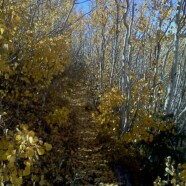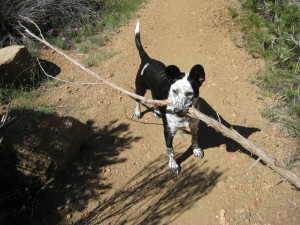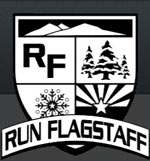Running with American Gods
I like running on trails and reading books, and sometimes combine the two. I load my iPod with audio books and take off into the forest. It’s not running meditation, but strangely satisfying. Audio reading requires concentration, so I find that I can’t run as fast, but that’s okay. I’m a slow reader, too.
The latest book I’ve “read” on the trails is Neil Gaiman’s American Gods. An awesome work of fiction. The novel follows a character named Shadow as he travels through the American landscape, working for a strange individual named Mr. Wednesday. Gods appear left and right in the story, reflecting past and present cultures. New gods battle old gods while Shadow tries to make sense of his life and the whirlwind of fantasy around him.
Blueberry, our tireless blue heeler mix, is my loyal running companion. She and I love the trails around Mt. Elden and on Campbell Mesa. She keeps a watchful eye out for things to herd, including flying ravens and falling leaves, and when there’s no real herding work to do, she finds the largest log around and carries it on the trail behind me.
If you’re in the mood to try a new trail running shoe, Brooks’ PureGrit shoes are worth a look. Light, minimal heel-to-toe drop, and cushiony for a minimalist shoe, they are comfortable and have a long life. I’m still rotating the same four pairs I bought last year, running between 80 and 100 miles per week with stability and comfort.It’s been a beautiful summer. Thank the American Gods there hasn’t been another Schultz fire this year. The monsoon rains are happening, freshening the air, greening our outdoor sanctuaries–these are sweet days in northern Arizona.Thanks for checking in.
Nikolai
“The Envelope,” a short story
I was tired of staying late at work—three days in a row, the last to leave. Shutting down my computer, I grabbed an environmental law book, and walked to the parking lot. What looked like a ticket was stuck on my windshield. I pulled it out from under the wiper blade; it was an envelope with my name typed on it: Aaron Strickland. Inside was a one-page summary of a psychiatric diagnosis from Dr. Dirk Bueller.
This had to be a mistake—or a joke. I wondered who would pull such a prank. The form looked authentic. North Country Mental Health Services was printed in professional script at the top. In the middle of the page was my diagnosis: Dissociative Identity Disorder. The form was signed at the bottom: Dirk Bueller, M.D. I drove home in shock.
After a sleepless night, I stumbled into work. I closed my office door and did a little research. Dirk Bueller was indeed a psychiatrist practicing locally. I considered making an appointment to see if he played a role in the psychiatric hit-and-run prank, but rejected the idea. How could a legitimate doctor put a diagnosis on the windshield of someone’s car? I looked up Dissociative Identity Disorder and learned it was the same as Multiple Personality Disorder. Its key feature, according to the Diagnostic and Statistical Manual of Mental Disorders, “was the presence of two or more distinct identities or personality states . . . that recurrently take control of behavior.”
I looked in the mirror in the bathroom and saw a tired, thirty-three-year-old face—a little haggard, but not crazy looking. The late hours and pockmarked sleep were catching up with me, but it was the same old me.
When I arrived home, the phone was ringing. I didn’t feel like answering, but picked it up anyway.
“Hello.”
“Hello Aaron, this is your brother, Mark,” said the slow, drawling voice of my older brother. A mistake answering the phone.
“Yes, what do you want, Mark?”
“How’s your mother?”
“Do you mean, ‘our mother?’”
“Your mother didn’t seem well the last time she visited here,” he said.
“Well, who would feel well visiting Bakersfield?” The town’s gateway sign reads: Sun Fun Stay Play – a suspicious invitation.
“Your mother complained about you.”
“What did our mother say?” I asked.
“That you don’t like how she folds napkins.”
“I never said that. And who cares anyway?” A momentary silence.
“Any more acts of self-love in public places these days?” he asked.
“Why did you call?” I asked again.
“Only one of us is living a righteous life, you know.”
I hung up. Fuck him. First the psychiatric diagnosis, then my sermonizing brother. Could things get weirder?
The next day, I ran some errands. I went to Olsen’s Grain and bought some dog food and cracked corn for the ducks. Thinking of the waddling ducks at the pond—Almond, AFLAC, Pony, Mange, among them—made me forget about my brother and the prank, but when I came out of the store and looked up, my heart raced. I saw a white envelope on my windshield. Please be an advertisement. But my name was typed on the envelope as before and the same goddamn diagnosis appeared inside. This time there was a sticky note on the form. It read: “You are very sick. You need to get treatment as soon as possible.” A faint acetone odor entered my nostrils.
* * *
“Good morning, Aaron,” said Dr. Bueller, smiling politely. He had the air of a successful professional, neither old nor young.
“Good morning, Doctor.”
“What can I do for you?”
“Well,” I began tentatively, “someone put a psychiatric diagnosis on my car windshield.” I swallowed. “It happened twice, actually.” I handed him the diagnosis.
Dr. Bueller looked puzzled. “What’s my name doing on this? I didn’t produce this form.”
“That’s what I thought,” I said.
“Have we even met before?”
“No.” I considered asking if he thought I could use psychiatric help, but how would he know?
“I don’t know what to say,” the doctor said. “You seem fine, but there would be no harm in conducting an examination.” He smiled.
I said an examination would not be necessary, and left his office more anxious than ever. How did his signature get on a diagnostic form with my name on it? Someone went to a lot of trouble for a stupid prank. Was I being watched? I decided to limit my trips away from home and keep a vigilant eye on my car. I wanted to catch the prankster.
When I woke up the next day, the world seemed different, not quite right, but nothing remarkable happened. No medical diagnoses came my way. I spent an awkward amount of time hanging around the coffee machine at work, looking out at the parking lot. I parked right in front of the large window in the office kitchen where it was easy to keep an eye on my car, but hard to stay focused on work.
That night I dreamed I was lost on the ocean, floating alone on a tiny lifeboat. Searching the horizon for a long time, I suddenly spotted a black dot in the distance. The dot grew larger, taking shape as a black mamba snake, but larger than anything found in the jungle. As the beast rifled toward me, its head rose six feet out of the water. I tried to paddle away, but it was too fast. The snake lunged forward over the boat, its fangs shining like diamonds, and struck—not me, but someone next to me. Wasn’t I alone? I turned to see who it was and saw myself with my mouth wide open as if silently screaming. I awoke, breathing hard and sweating.
* * *
“I’d be okay if I never saw you again.” Kind of a harsh thing to say to one’s mother, but it hasn’t always been smooth sailing between Mom and me. The above words were triggered when mom refused to hug me goodbye. I let it rip. But there have been good times as well, often taking place around bodies of water. The play of sunlight upon the water, the dance of grass in the breeze, the sweet, algal smell—my mom and I have found peace in such places.
“Almond!” my mom shrieked. I looked where she was pointing and saw an Indian Runner duck paddling fast toward us. We had not seen Almond in months and were worried about her. Because Indian Runners cannot fly, they are especially vulnerable to predators. But here she was, on shore now and running fast toward us.
“Don’t bite my finger!” Mom said to an excited Almond eating from her hand. Other ducks soon adopted Almond’s boldness and began eating from piles of cracked corn we poured on the grass.
“I could do this everyday of the year and never tire of it,” my mom said.
“Me, too,” I said. “Remember the two kites in A Christmas Memory?” It would be hard to forget Truman Capote’s story where “a lost pair of kites” symbolized two hearts forever linked. My mom looked out over the water, smiling. The ducks were full and sauntered away. Our tensions followed them onto the sun-drenched water like ducklings following their mother, leaving us cleansed and peaceful.
The next few days went by uneventfully. No envelopes, doctors, or black mamba snakes. But dark flood waters eventually returned. Getting out of my car one morning at work, I had a queasy feeling something wasn’t right. Was I being shadowed? From the parking lot, I looked into the big kitchen window. For a moment, I thought I saw someone standing by the coffee machine, but realized it was just a reflection of me from the outside. I grabbed the environmental book, closed the car door, and looked again at the window. I saw reflected there a man removing an envelope from my windshield. Or was he leaving an envelope? I squinted. My eyes remained fixed on the window. Someone was watching me, but I could not tell if I was placing or removing an envelope.
~ by Nikolai Lash
Read MoreRe-examining Glen Canyon Dam Operations
The Department of Interior is re-examining Glen Canyon Dam operations in what is called the Long-Term Experimental and Management Plan Environmental Impact Statement, LTEMP EIS. Following are comments I wrote for Grand Canyon Trust:
Grand Canyon Protection Act Rules
Several federal laws have been passed to protect Grand Canyon, but prominent among them is the Grand Canyon Protection Act (GCPA), signed into law on October 30, 1992. The GCPA states:
The Secretary shall operate Glen Canyon Dam in accordance with the additional criteria and operating plans specified in section 1804 and exercise other authorities under existing law in such a manner as to protect, mitigate adverse impacts to, and improve the values for which Grand Canyon National Park and Glen Canyon National Recreation Area were established, including, but not limited to natural and cultural resources and visitor use.
The intent of the GCPA is unambiguous: to operate the dam in a manner that protects park resources, notwithstanding impacts to hydropower generation. Senator John McCain, co-sponsor of the bill stated:
The erratic release of water from the dam to meet peak electric power demands has destroyed Colorado River beaches, and harmed other natural, cultural, and recreational resources. Somewhere along the line, we forgot our obligation to the canyon and to the future generations for whom we hold it in trust.
The destructive “erratic releases” Senator McCain refers to are the ceaselessly fluctuating flows from Glen Canyon Dam that generate cheap peaking power but, in the bargain, unravel the health of Grand Canyon. Fluctuating flows erode sediment faster than steady flows, diminishing beaches, harming native fish habitat, eroding centuries-old cultural sites, and jeopardizing the existence of the 4-million-year-old humpback chub, an endangered fish found only in the Colorado River.
New Flows Needed from Glen Canyon Dam
Before Glen Canyon Dam’s existence, Grand Canyon was characterized by huge sweeping beaches built up with raging snowmelt floods in the spring. The wind picked up the beach sediment and carried it inland, burying a multitude of archaeological sites. Water temperature varied from freezing in the winter to a balmy 85 degrees in the summer. Eight native fish, supremely adapted to these harsh conditions, thrived in the mainstem and tributaries. River runners during the twentieth century began taking advantage of these huge beaches for camping.
Glen Canyon Dam blocked the Colorado River in 1963 and initiated a cascade of ecosystem changes. The dam traps about 85 percent of the annual sediment supply for Grand Canyon — the other 15 percent coming from tributaries within the canyon. In addition, water releases from the dam were altered to generate the maximum amount of peaking hydropower. The loss of sediment supply and the greatly increased rate of erosion from flows designed to maximize hydropower set in motion the continual loss of sediment from Grand Canyon. Research on annual sediment balance has shown only one year when Grand Canyon has not lost sediment, and this one positive year resulted from a unique sequence of late season flood events.
The loss of sediment from Grand Canyon has resulted in fewer and smaller beaches. It has also eliminated significant critical habitat for native fish. Sediment deposits create complex shorelines and underwater features that are used by native fish for spawning and rearing. Four of the eight species of native fish that once plied the waters of Grand Canyon have already been lost. A fifth species, the endangered humpback chub, is vulnerable to being lost from Grand Canyon because virtually all spawning and rearing habitat has disappeared from the mainstem.
The continual loss of sediment from Grand Canyon has also resulted in archaeological sites being exposed to erosion and impacts from visitors. Historically, these sites were protected with a regularly renewed layer of sediment derived from the beaches and transported by the wind. Without the influx of new sediment, we constantly lose these irreplaceable features of our cultural heritage.
The way in which water is released from Glen Canyon Dam has profound effects on the river corridor, the species living there, and the abundant cultural sites. Simply stated, water can be released as either steady flows or fluctuating flows. Neither flow regime impacts water supplies or water deliveries by the Colorado River; however, over the last 15 years, science has shown that fluctuating flows damage all the key resources in Grand Canyon–the beaches, the backwater habitats for native fish spawning and rearing, the native shoreline plants and animals, and cultural and archaeological sites. At the same time, scientists have concluded that steady flows are very likely to be optimal for all sediment-related resources. A recent report from Grand Canyon Monitoring and Research Center concluded that fluctuating flows following the last high-flow experiment quickly eviscerated the benefits created by the high flow.
Two types of flows are needed: 1) regular high flows under sediment-enriched conditions to deposit sediment from tributaries and to scour sediment from the bottom of the river to rebuild beaches and near shore habitat for native fish, and 2) seasonally-adjusted steady flows, based on the natural rhythms of the pre-dam river, which would preserve beaches, protect native fish habitat, and stabilize centuries-old cultural sites.
General Issues
Park resources continue to decline under current dam operations and a change is needed now. It is critical that the LTEMP alternatives consist of alternative dam operating criteria (in concert with other management actions) designed to meet the requirements of the Grand Canyon Protection Act.
In addition to the GCPA, alternatives must be consistent with the many laws and policies that govern water releases, park resources and values, and hydropower production. Because of the trade-offs inherent in managing these resources, Congress has established priorities by enacting the GCPA. The GCPA makes it clear that dam operations must be guided first by meeting the legal requirements for water delivery to the lower basin, and then by the need for protecting park resources and values. All other considerations, including hydropower production, are a lower priority.
The Colorado River Ecosystem (CRE) has been drastically altered by the presence and operation of Glen Canyon Dam and other changes, and achieving the resource objectives for the CRE will require bold action. Thankfully, there is a tremendous pool of scientific information from the CRE and other river systems that is available for developing and testing alternative dam operations and other management actions to meet the requirements of the GCPA.
Specific Alternatives and Issues
Steady Flows Conserve Sediment and Warm Water
Most of the resources of concern in Grand Canyon are reliant upon sediment in one way or another. Sediment conservation should thus be a key component of all alternatives considered in the LTEMP EIS. The best flows for conserving sediment are steady flows. A USGS Fact Sheet (Publication #2009-3033) summed up the science position on steady flows in Grand Canyon this way:
For a given volume of water to be released from Glen Canyon Dam, the optimal dam operation for accumulating tributary-supplied sand is a constant, steady flow over the entire year.
Steady flows also warm river water, especially near the shoreline. This is important as native fish need warmer temperatures to successfully reproduce. Two specific types of steady flows should be considered as alternatives in the EIS:
- Seasonally-Adjusted Steady Flows. The steady flow regime that most closely resembles pre-dam flows is called Seasonally-Adjusted Steady Flows (SASF). SASF can take many forms, but its most basic outline contains high steady flows in the spring, perhaps accompanied by a High-Flow Event, followed by low steady flows in the summer and fall. In addition to conserving sediment, this flow regime can also significantly warm shoreline waters. Because of low summer steady flows, water temperatures can rise to a level that supports spawning and rearing of the endangered humpback chub. GCMRC should be asked to develop an SASF alternative, consistent with sediment conservation and improved native fish habitat.
- Year-Round Steady Flows. This is the “best case scenario” for conserving sediment presented in the article, “Is There Enough Sand? Evaluating the Fate of Grand Canyon Sandbars” (Wright and others, 2008). It is based on the conclusion that the “optimal intervening dam operation for rebuilding and maintaining sandbars is year-round steady flows, which would export the least amount of sand compared to other potential dam operations.” (USGS Circular 1366, page 143)
Four-Year Experimental Blocks
Because of the uncertainties attending any new flow regime, one possible alternative would be a 12-year series of three four-year experimental blocks that test the pros and cons of both kinds of steady flows described above. The 12-year experiment might begin with four years of Seasonally-Adjusted Steady Flows, followed by four years of Modified Low Fluctuating Flows for comparison’s sake, and finish with four years of Year-Round Steady Flows. At the end of the 12 years, all three flow regimes would be analyzed to see which produces the best results for the resources in Grand Canyon, consistent with the Grand Canyon Protection Act.
High-Flow Events
High-Flow Events (HFEs) should be a part of all alternatives. High flows done on a regular basis when sufficient sediment is in the river system can help build beaches and improve other sediment-related resources.
The current limit of HFEs to 45,000 cfs should be changed. Sediment science suggests that flows of 60,000 cfs and more would be extremely beneficial for the sediment-based resources in Grand Canyon. Before Glen Canyon Dam was completed, the annual spring snowmelt floods ranged between 35,000 and 120,000 cfs. Beaches, native fish habitat, cultural sites, and other resources would benefit by regular HFEs that mirror these pre-dam floods.
2007 Shortage Criteria
Modified Low Fluctuating Flows plus equalization flows equals massive destruction of Grand Canyon. Because of the guidelines adopted in the “Colorado River Interim Guidelines for Lower Basin Shortages and the Coordinated Operations of Lake Powell and Lake Mead” (Interim Guidelines), huge equalization flows were released in 2011, transporting a record amount of sediment from Grand Canyon, dramatically eroding beaches and damaging Grand Canyon resources.
The Interim Guidelines as adopted has set back sediment conservation in Grand Canyon several years. Higher flow volumes have a direct effect on sand transport, a fact corroborated in the modeling simulations of sand transport for hypothetical annual release volumes as published in USGS Open File Report 2010-1133, “Evaluation of Water Year 2011 Glen Canyon Dam Flow Release Scenarios on Downstream Sand Storage along the Colorado River in Arizona” (Wright and Grams, 2010).
To remedy this situation, the Interim Guidelines should be amended to include consideration of the requirements of the GCPA. It should also explicitly be acknowledged that when equalization is required, larger flows can and should be released over a two- or three-year period. This longer term of releases would still satisfy the criteria for moving water from Powell to Mead, but would do it in a manner that better protects the resources in Grand Canyon.
Extirpated Species
A plan to reintroduce extirpated species in Grand Canyon should be a part of all alternatives considered in the LTEMP EIS. These might include: the river otter (Lutra canadensis), razorback sucker (Xyrauchen texanus), Colorado pikeminnow (Ptychocheilus lucius), and bonytail (Gila elegans)).
Reintroducing extirpated species is one of the 12 goals highlighted in the Stategic Plan of the Glen Canyon Dam Adaptive Management Program. It is also a park value supported by the Grand Canyon Protection Act.
Sediment Augmentation
The EIS should examine options for mechanically introducing additional sediment below the dam, to augment that which is periodically available from tributaries.
Temperature Control Device
The natural flow cycle of the Colorado River before Glen Canyon Dam was constructed included a seasonal warming trend in the late summer as the water temperature increased to approximately 85 degrees. After the dam was constructed, the temperature of released water became relatively steady at between 45-50 degrees as water was drawn from the deep penstock intakes. Even though the released water warms as it moves downstream, it still does not normally the temperature that allows endangered, warm water fish, such as the humpback chub to reproduce in the mainstem of the Colorado River.
The EIS should actively evaluate the efficacy of implementing a Temperature Control Device that would provide temperature control flexibility and improved water quality. A selective withdrawal structure or other methodology could improve the ability to create productive habitat for endangered fish and also offer more flexibility to respond to changing ecosystem concerns in future years.
As stated in the 1995 Glen Canyon Dam FEIS:
Increasing mainstem water temperatures by means of selective withdrawal structures installed at Glen Canyon Dam offers the greatest potential for creating new spawning populations of humpback chub and other native fish in Grand Canyon.
Summary
It is critical that the LTEMP alternatives consist of alternative dam operating criteria in concert with other management actions designed to meet the requirements of the Grand Canyon Protection Act while being consistent with other laws including those regarding water delivery, endangered species, cultural resources, and water quality. The alternative selected as best meeting these criteria should then be tested for the appropriate number of years to achieve the desired level of confidence in the results.
The LTEMP provides a public opportunity for Interior and the responsible agencies to accomplish something big — to meet in full the requirements of the Grand Canyon Protection Act. To do this, the LTEMP must be intellectually honest, legally defensible, scientifically credible, and reflect the high value the public places on the integrity of the natural, cultural, and recreational resources in this most iconic of national parks.
~Nikolai Lash
Read More





